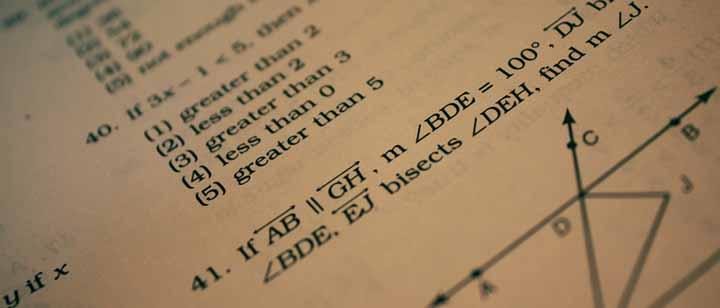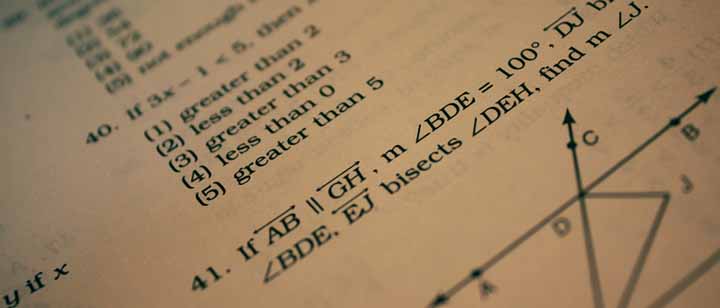Nervous about the math portion of the SAT? Grab an SAT math practice test, sit down, and review these helpful tips from Merrick, NY tutor Justin L...
After you’ve taken a SAT math practice test or two, most students can admit that the actual “math” on the SAT really isn’t that tough — it’s figuring out what they actually have to do.
Sure, there may be a few shaky topics here and there or something that your teacher hasn’t gone over too much, but for the most part it’s not the actual calculations that frustrate most people. The real challenge comes from digging through the question to figure out what it is they actually want you to do. So to help you through this, I’m going to share some pro tips and get you heading in the right direction.
1) Underline
Underline important information: what X is, what Y is, or anything else that may seem important. Even if you’re not sure, the act of sitting there with your pencil and looking for these things as you read will help you retain the information. I know it sounds silly and way too easy, but if you make a visual trigger for your eye to jump to, you will be able to spot the important info quicker.
When dealing with word problems that are presented as daunting paragraphs, check out the last line or two first. The College Board tends to hide your actual goal at the end of a question. Underline it! Do that first and then read the question. You will have a better understanding of what to do if you know that you have to solve for X (or whatever they may want) at the very beginning.
2) Skip Multiple Choice Questions
Don’t do the questions you can’t get right. Yes, skip them. I’m not going to explain the scoring right now, but if you skip the hard questions, topics that you usually can’t do, and/or the last two multiple choice questions, you will end up better on time, less stressed out, and your score will jump. Try not to skip the first five multiple choice questions and never skip a student-produced response ever! The part twos where you actually come up with the answer and grid in the number do not penalize you if you get them wrong the way multiple choice questions do. Even if you have no clue, just grid in an educated guess.
3) Draw
The geometry questions can be very vague and many students aren’t sure where to start. So always draw a picture and label everything that you can. Most of the time, that’s the hardest part. Once you get everything labeled, just fill in all your blanks. Fill in every angle and side you can, jot down area and perimeter if you can, and then go back to the question. Once you get all the info illustrated and (neatly) labeled, go back to the question. Your handy-dandy diagram will have everything you need to get the answer.
4) Plug In Numbers
If your question is all variables, and those same variables are in your answers, just plug in numbers. Technically, any number will work. Just be smart about it. Use nice, easy, happy little numbers like 2, 5, or -3. Stay away from big ugly numbers like 19 and stay away from multiples of the same number. If you have to select three numbers to plug in and your first choice is 5, don’t use 10, 15, or 20 as your other numbers. Write down in your test book what you’re plugging in. You will forget. Trust me. Jot down what number you are using for each letter, plug them into the question, get a real answer, then take your numbers that you picked and plug them into the multiple choice answers. One of the multiple choice answers will match what you did.
Let me give you an example. Tom works h hours at p dollars an hour. So let’s say this guy works 4 hours (h=4) and gets $10/hr (p=10.) It looks like Tom is going to bring home $40 for the day. Take your 4 and 10. Plug them into all of your multiple choice answers and see what comes out to your answer of 40. One of the answers would be p x h and that would be it. If you have a match then you have a correct answer.
5) Don’t Freak Out
Take a deep breath and relax. The formulas are there for you. There really isn’t that much you need to memorize; make yourself a one-page study guide of things to remember and you will be fine. Skip the hard questions. Make sure you use a pencil. Make sure your phone is off. If you made the effort to prepare, did a few SAT practice tests, do well in school, read for fun, and maybe play a little chess you will succeed. Don’t freak out.
Justin L. teaches ACT math, PSAT, SAT, and test prep in Merrick, NY. He received his Bachelor of Science in Math and Masters of Arts in Math Education at Adelphi University. Justin has more than six years of experience working with students privately, in classrooms, as well as store-front tutoring companies. Learn more about Justin here!
 Photo by Aaron Escobar
Photo by Aaron Escobar
Suzy S.


